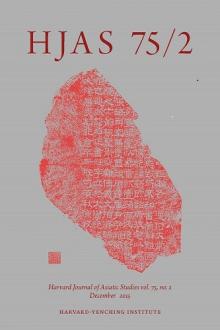December 2015
Details: Han Xiping shijing houji canshi 漢熹平石經後記殘石, circa 1912–1945.Rubbing from Han-era stele fragment; paper, ink, intaglio; 54 x 40 cm. No.TP0970, Harvard-Yenching Library, Harvard University, Cambridge MA [online version available through the Hollis Catalog (no. 9788564)]. Photo: Imaging Department © President and Fellows of Harvard College.
Editorial Preface
In Memoriam, Timothy Conner, 1942–2015
Articles
The Music Teacher
The Professionalization of Singing and the Development of Erotic Vocal Style During Late Ming China
I focus on the professional singing teacher as a new social identity during the late Ming, particularly their social transformation from anonymous grifters to meaningful names in the elite singing culture of kunqu. A close, intertextual reading of different versions of Wei Liangfu’s (fl. 16th century) singing thesis, Nanci yinzheng—combined with historical, fictional, dramatic, and poetic accounts of musical performance given by professional singing masters and their courtesan students—reveals how the professionalization of teaching music resulted in the low rate of musical literacy among commoner-singers and the renowned erotic vocal style of the late Ming. In this process, moral critique, sensual pleasure, and technical criticism were more closely intertwined than has been generally believed.
本文關注晚明曲師如何從無名小輩升級為崑曲演唱之精英文化中的關鍵人物。通過《南詞引正》版本比勘,分析有關曲師和妓女演唱的文獻,本文闡述晚明音樂職業化的後果:普通人視唱的低水平和演唱的色情風格——一個道德批判、感官享受和細節批評同時並存的歌唱文化。
The Boy Who Lived
The Transfigurations of Chigo in the Medieval Japanese Short Story Ashibiki
This article casts new light on the fifteenth-century “acolyte tale” Ashibiki (The mountain) as well as on the genre as a whole. In an archetypal acolyte tale, the protagonist (chigo)—often an avatar of a bodhisattva—dies a tragic death, awakening his surviving lover, a monk, to the emptiness of carnal desire. Perhaps due to the adversities the chigo endures in Ashibiki, previous scholarship has likened this tale to the archetype, although Ashibiki makes a stark contrast within the genre. By employing the “stepchild story” as a framework for re-interpretation, I argue that Ashibiki is a triumph story of a stepchild who is initiated into adulthood by surviving numerous hardships. Furthermore, based on careful analyses of several acolyte tales, this article challenges prevalent assumptions that chigo-monk relationships were inherently exploitative and acolyte tales were created for legitimating the institutional sexual abuse of adolescent boys.
僧と稚児の悲恋を描く稚児物語は、仏教寺院の組織的な少年虐待を正当化する言説として解釈されがちだが、本稿は稚児制度がアプリオリに 性的搾取の構造を持つという前提に依拠せず、『あしびき』の分析を通して、稚児物語の再検討を試みるとともに、『あしびき』の継子譚としての構造を明らかにする。
Unearthed Documents and the Question of the Oral versus Written Nature of the Classic of Poetry
Prominent Western scholars have proposed that the Shijing was produced in a largely oral context and that writing played little role in the creation and subsequent transmission of the poems. Recent discoveries of several manuscripts of and about these poems call into question this view. I examine these recently published manuscripts as well as other types of paleographic evidence to show that writing played a crucial role in each of the three phases of the Classic of Poetry’s early history: its redaction during the Han dynasty, its transmission over the course of the Eastern Zhou period, and the original creation of at least some of the poems during the Western Zhou dynasty. I do not claim that oral influences played no role in the creation, transmission, and redaction of the text, but I do suggest that these influences have been overemphasized in recent Western scholarship.
西方學者多論證《詩經》產生於口述文化環境中,以為在《詩》的創作和傳授過程中書寫沒有起多少作用。然而,最近出土的幾份《詩經》和與《詩經》有關的早期寫本對這種說法提出重大的質疑。本文根據些寫本以及其他出土文字資料論證書寫對《詩經》早期歷史的每一階段都起重要作用。
On a Han-era Postface (Xu 序) to the Documents
Qu Wanli once wrote, “Of all the Classics, the Documents is the most difficult to put in good order.” In an attempt to untangle the complex, often contradictory statements about that text found in pre-Han, Han, and immediately post Han sources, this article takes on a seemingly minor part of the larger puzzle requiring resolution: did there exist during pre-Han and Han times a preface/postface (xu 序) to a 100-pian Documents, representing a compilation by Kongzi (Confucius) himself that passed down uninterruptedly for centuries within the Kong family? Clearly, if such a work existed, it would have served as a supremely authoritative guide for how to read the classic, and hence a reliable witness to the entire history of the distant Chinese past with its many sage-kings and worthy ministers. Contra much recent scholarship devoted to the so-called 100-pian xu, this article adopts the view that no such genuinely early xu existed for the Documents.
《尚書》歷來是儒家五經中糾紛最多、最難讀通的一部。本文僅嘗試對其中一個小問題進行探索:是否存在一部由孔子編纂並在孔氏家族內部一直流傳到漢代的百篇《書序》?如果存在,它無疑會是人們讀經的權威指導和三代歷史的可信見證。但我們得出的結論是否定的。
